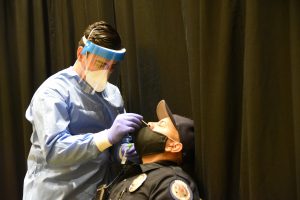- Slug: BC-CNS Arizona COVID Surge, 705 words.
- 1 photo and caption below.
- 1 graphic here.
By Adianna Bermudez
Cronkite News
PHOENIX – Arizona is experiencing a COVID-19 surge similar to the one it saw in mid-June, and a vaccine that will get the population closer to herd immunity is in the distant future, the director of ASU’s Biodesign Institute said Wednesday.
“We are very close for a seven-day trailing average to crossing the 1,000 new cases a day mark,” Joshua LaBaer, institute executive director and professor at Arizona State University, said at an online news conference.
LaBaer said distributing a vaccine, once it’s developed and approved, will take some time. He urged Arizona residents, even though they are weary of the pandemic and its economic toll, to continue to wear masks, social distance and get tested every week until a reliable vaccine is ready.
The Arizona Department of Health Services has drafted a COVID-19 vaccination plan that allows county health departments and tribal health partners to decide who gets the vaccine in their communities.
The draft says ADHS will look to the federal Centers for Disease Control and Protection and other leading health organizations to prioritize vaccinations. The priorities now are teachers, health care and food-industry employees, people with limited access to routine vaccination services, such as those with disabilities or who live in rural areas, and those who are at higher risk of severe COVID-19 illness, including people older than 65, people of color and those with underlying medical conditions.
Those at higher risk of spreading the disease, such as people in the military or attending college, also are on the vaccine-priority list.
The ADHS plan says those priorities are likely to change as new data emerges and the vaccine availability fluctuates.
Arizona has reported 233,912 cumulative cases, with 975 of those positive cases reported on Wednesday. The death toll now stands at 5,854.
As of Oct. 21, ASU had 2,009 cumulative positive tests from students out of 91,121 tests administered, according to the university’s COVID-19 website. Faculty had 46 positive tests. Two days earlier, ASU reported a daily total of 93 known positive cases among students and 11 among staff and faculty.
LaBaer said the state surge began at the end of September and continues to climb, which is similar to the rest of the country. COVID-19 cases have increased in recent weeks across the country, with 17 states breaking records. Case numbers in the U.S. have topped 8 million, and have surpassed 40 million worldwide. More than 220,000 Americans have lost their lives to the disease since January.
LaBaer said the latest surge in Arizona shows an increase in cases in younger people and fewer hospitalizations than the surge in June. Hospitalizations have been fewer because younger people are better able to withstand the novel coronavirus that causes COVID-19 and medical professionals are learning how to better treat it, he said.
“I am hoping that because we have been down this road before and Arizonans know what this looks like, that we can respond to this quickly,” LaBaer said.
Mitigation efforts, such as masks, social distancing and frequent testing, worked in previous surges and will work again, he said. LaBaer recommended businesses stay open but conduct safe practices.
“I appreciate that we are fatigued from COVID-19,” LaBaer said, adding that Arizonans relaxed when COVID-19 numbers dropped, becoming more comfortable with not wearing a mask.
“Masks without a doubt work,” he said.
“Testing is one of our best tools,” he added, noting that ASU saliva testing sites are in almost every county, with multiple sites in Maricopa County.
“If you interact with new people every day, why not get tested every week for free?” LaBaer asked.
“We, for better or worse, have to find ways to work with these mitigation factors.”
LaBaer added that 70% of people who are infected do not spread the disease.
He said about 80% of the spread occurs from about 5 to 10% of the population who interact with large groups, known as superspreaders.
He referenced the Sturgis Motorcycle Rally, churches and the White House as examples of superspreader events.
LaBaer said there’s no way to eliminate COVID-19 entirely, as other coronaviruses will remain.
However, he said 90% of people have not encountered COVID-19, meaning there are still many people who could get sick.
“We are nowhere near herd immunity right now,” LaBaer said.
For more stories from Cronkite News, visit cronkitenews.azpbs.org.
^_=
